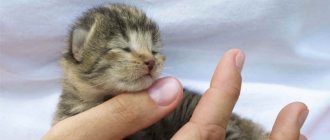Reasons for behavior
Cats are freedom-loving and self-sufficient animals. Professional trainers know that it is almost impossible to force them to do something against their will, even force a cat to sit in your arms. Cats have different personalities from each other, just like people. Some are more affectionate, patient, friendly and capable of purring for a long time on their owner’s lap, others are strict and independent, not allowing themselves to be simply petted. British shorthair and fold-eared cats are especially susceptible to this. Often the cat chooses its own place in the apartment and, if it does not want to sit in your arms, nothing can be done, but sometimes it can be tamed.
© shutterstock
Here are the main reasons why a cat won't sit in its owner's arms:
- The kitten is constantly on the move. If something distracts his attention, he will not sit on his hands;
- Pungent odor from the owner. The cat's nose is very sensitive and does not like the smell of lemon, orange, alcohol, spices, washing powder, creams and perfumes;
- Memories of past grievances. If the previous owner beat the kitten, offended him, or if the cat grew up on the street and is not used to affection, he may not give in and not be handled. The cat will not sit in the arms of the person who offended him;
- Some animals are so independent that they don’t like being picked up by anyone, even their beloved owner. They begin to hiss and bite in response, expressing displeasure;
- The cat does not like to sit on laps because he is afraid of heights and loss of balance;
- The cat doesn't like to sit in other people's arms. He can perceive and love only the owner, but not the members of his family;
- A street cat does not like to sit on laps, as it is unfamiliar with tenderness and affection. Over time, he begins to shun any manifestations of tenderness;
- A purebred animal. British and fold cats do not like to be handled, remaining self-sufficient and independent;
- Fear. If an animal is scared, it will not be affectionate even with its owner. Cats cannot tolerate sharp sounds, screams, they can become frightened and in this state it is difficult even to simply pet them;
- The cat does not like to sit in the arms of children, as they squeeze it and offend it. Even if the child has grown up and doesn’t do this anymore, the cat remembers the insult and no longer asks to be held in his arms.
A characteristic feature of all cats is independence, resentment and vindictiveness. They will never sit in the arms of a person who offended them, hit them, or drove them away. The cat will not do anything against its will, much less sit in your arms. You need to make her want to do it.
© shutterstock
Features of training pedigree cats
Purebred cats are taken from friends, pet stores, nurseries and shelters. They teach rules of behavior consistently and patiently.
Hemorrhoids in cats, cats and kittens: how to treat
First, the cat is given a nickname, short and sonorous. They repeat it often and kindly. When he responds and approaches, he is rewarded with a treat. They constantly talk to the ward. Cats understand not words, but intonation. They react sensitively to the mood of the owner and understand the mood by tone.
At the same time, they are taught to behave correctly. One command is a ban, then, when the cat understands and begins to comply, another useful habit. The kitten is given an understanding of what it should not do: bite its owner, scratch furniture. Forbidden "Ugh!" and “You can’t!”, accompanied by the clapping of palms, the pupils understand quickly.
Important! The animal is rewarded for following commands, and punished for misdeeds. But immediately, and not in a few hours, the cat will not understand and will harbor a grudge
Beatings are unacceptable.
Pets are taught not to climb on the table. They are taught to eat in one place and from the same utensils, to go to the toilet using a tray or toilet. Poking a kitten's nose into its puddle is inhumane and pointless. It is better to patiently lead him to the right place, stay with him, and encourage him after the right actions.
Toys for pets are important in the process of getting used to a new place
Is it possible to lift an adult animal by the withers?
It is not recommended to lift your pet by the skin between the shoulder blades. If mother cats move their cubs from place to place in this way, this does not mean that this method of movement is also suitable for adults. It is forbidden to pick up and hold representatives of the cat family by the withers, because after 3 months of age they become quite large and heavy, and such an action can lead to a neck injury.
Is it possible to make a cat affectionate?
If there is a little five-year-old monster living at home, even in six months it will not be possible to turn him into a gentle princess - cats are stubborn and conservative to the extreme. However, with due patience and free time, even a wayward aggressive cat can be taught affection and trust.
Interesting materials:
How long does it take to register an LLC with the tax office? How long does it take to change Okvad? How long does Transcription take? How long does it take to withdraw money from 1xbet? How long does it take to charge a 3000 battery? How long does it take the Earth to rotate around its axis? How long does a porcini mushroom live? How long do chickens live? What is cumulative working time? Summarized working time recording - what is it?
Is it possible to tame an adult cat to a new owner?
A cat tolerates a change of owner more easily than a dog. The exception is socially oriented breeds, for example, Oriental Siamese. They will gradually become affectionate with their new owners, but the first one is the only one for life.
The best way to train, even for a sexually mature individual, is not food, but play. First, an adult cat must get used to the territory. It is better to leave your pet to explore its new home on its own, and after a while offer some food from your hands. Just like a treat. At the same time, do not forget to talk measuredly, but not to stroke.
As soon as the cat gets used to it a little, you can:
- lightly scratch a chair or furniture - so that the cat reacts to the sound near the owner;
- roll a ball or ball of wool near you, inviting you to play;
- “drive” a candy wrapper.
The cat quickly joins the game. After a while, you should again give a piece of food from your hand and praise it.
How to accustom a cat to your hands
You can try to accustom your cat to physical contact, but you need to do this gradually, and do not insist if the animal does not like something. Forced stroking can only aggravate the situation; the cat will break free, most likely, it will begin. If you hold a cat forcibly in your arms, it will be afraid and may begin to hide from people, seeing an intention to touch it.
It is easier to train a kitten or young cat to sit in your arms than a mature cat. When accustoming a timid cat to your hands, for starters, you can limit yourself to a light touch with your fingertips; it’s better to do this in passing, after which you should leave the cat alone for a while. Gradually you can move on to occasional, unobtrusive stroking in the direction of fur growth.
Having turned such stroking into a kind of ritual, you need to let the cat get used to it, and only then move on to greater intimacy. You can try feeding your cat from your palm so that it is not afraid of your hands. You can pick up the cat when it stops avoiding touching, and you don’t need to hold the cat if it starts to resist.
To get closer to a cat, some experienced owners recommend encouraging it with some kind of treat, so that the proximity of the owner’s hands evokes positive emotions in it. You can use catnip for the same purpose, but you should not get carried away with the aromatic bait to prevent addiction.
By showing patience, an attentive owner will be able to reach an understanding with his pet and, perhaps, the cat will share his desire and, over time, will begin to enjoy sitting in his arms. If this does not happen, then the owner will have to come to terms with the cat’s character and not insist. If a cat does not want to sit in a person’s arms, this does not mean that she does not love him.
Owners of special cats are perplexed; they do not understand why their pets do not like stroking and attention. Beginning breeders imagined their new host as a companion who would sit on their knees and purr. However, a huge number of cats want independence, but they don’t like to spend time on their owner’s lap. Before you shout that cats are ungrateful creatures, you need to understand what causes the animal’s alienation.
Why won't my cat sit in my arms?
© stuffcatswant.com If you have a cat at home, you, of course, have picked it up more than once. While not all cats enjoy being held, most cats at least don't mind it. Usually you can rock the cat like a baby or put it on its back - it will react quite calmly to this. When the cat wants to be let go, she will let you know by starting to push you with her paws, but, for the most part, this does not happen soon enough; the cat quite favorably accepts the attention of a person. Cat in your arms? However, it is not so rare among cats to come across individuals who do not like to be held. As soon as such a cat suspects that they are going to pick it up, it tenses up and, if possible, strives to increase the distance from the person. Once caught in your arms, even in the “grip” recommended by veterinarians (one hand under the chest, the other under the hind legs), the cat, if it does not break free, remains tense, like a spring, the entire time it is being held. It is quite obvious that in such a situation the cat does not experience any pleasure and strives to free itself as quickly as possible. So why do some cats love to be held while others avoid it at all costs? There are reasons that determine a cat’s attitude towards hands and methods that allow you to correct its behavior. Life experience of a cat. The behavior of cats is greatly influenced by the experience they receive in childhood of interacting with people. Unfortunately, it is not always known how the first months of your furry friend’s life went, and this is a decisive period in the socialization of a kitten. Perhaps as a kitten, the cat did not receive enough human attention, so it did not form positive associations with human hands. However, it is possible that the decisive factor is simply the personality of a particular animal. However, one of the most likely reasons why your cat doesn't like to be handled is because of past negative experiences. Who knows, maybe when she was a kitten she was dropped several times, maybe someone pulled her ears or tail? All this can lead to the fact that the cat, as an adult, will be very wary of human hands. Another reason could be events that people do not perceive as negative, but for a cat they are. A striking example is a visit to the veterinarian - cats in the vast majority of cases perceive such events extremely negatively (this is understandable - which of us liked visiting doctors as children). As a result, the cat may assume that it is being picked up to be taken somewhere where, of course, extremely unpleasant things await it. The cat is just afraid. No one has ever seen one adult cat pick up another. A cat can only be lifted from the ground in early childhood, when the mother carries the kitten from place to place. At the same time, kittens completely transfer control over themselves to the cat - this is an instinct developed in the process of evolution. On the other hand, adult cats are generally not inclined to allow other cats to approach, even if both animals are very friendly. They need to take a closer look and sniff each other first. A person is not only much, much larger than any cat (even a Maine Coon), but also strives to very quickly pick up a cat, not allowing her to prepare for this. Imagine yourself in a situation where a certain creature, even usually harmless, but no less than 10 times larger, suddenly appears, lifts you up and starts rubbing the hair on your head! There is something to panic about! The creature can easily crush you - by accident or on purpose, who knows what is on its mind? Possibility of bruise or injury. If your cat doesn't mind being held, but runs away every time you try to pick her up, there are two possible reasons. Negative experiences have already been discussed above, but if you can confidently rule them out as causes, there is a chance that the cat may be sick or injured. To check, it's probably worth consulting with your veterinarian to check for possible injury or medical conditions that may be causing pain when you lift your cat. Even after the medical problem is resolved, the cat may continue to avoid human hands because it associates them with the pain it previously experienced. Impossibility of escape. When a cat is picked up, it perceives this as a form of restriction of freedom of movement (similar to placing it in a carrier). The cat, being a small animal, always prefers to have a way to escape - this is one of the important factors for survival in nature. In addition, although this does not happen every time she is picked up, it is not difficult for the cat to conclude that the possibility of an unpleasant continuation cannot be ruled out. Maybe they are going to trim her nails, bathe her, take her temperature, put her in a carrier, etc. The cat needs to be handled correctly. Perhaps the cat doesn’t like the way you pick it up. In any case, the cat must be lifted and held carefully, as it can easily be injured. It's best to stick to the standard "two-point method" - one hand supporting the cat under the chest, the other under the hind legs. How to hold a cat correctly? Brief summary. All of the above leads to the conclusion that answering the question of why some cats do not like to be picked up is quite difficult, even if you have known your cat since she was a kitten. The reason may lie in both character traits and negative experiences gained when you were not at home. A cat may simply be afraid because of the size of people or because being held is sometimes followed by a trip to the veterinarian or groomer. This article is not intended to provide recommendations for changing this particular behavior, it simply encourages respecting the cat's preferences as it is an individual, although it is understandable that we all love to hold cats from time to time and sometimes simply cannot resist the temptation .
Some training methods
If you are not one of those lucky people whose cats love to sit or even sleep in your arms, and you really want your pet to be “tame,” then you need to know that there are different ways to help tame this wild miracle:
- All cats love to eat tasty food, and it is better for a well-fed, dozing kitten to allow itself to be taken on your lap.
- An affectionate monotonous conversation with a pet encourages mutual communication. He, listening to the owner’s gentle speeches, will begin to squint and squint. In this state of mind, the pet will jump into the owner's arms.
- Animal psychology claims that a cat should get used to being handled gradually, in several stages. First you just need to pet her behind the ear, all cats adore this. Once the pet is near your palms, you do not need to grab it and hold it by force.
- You can act with the help of treats. At first, you can feed the kitten by hand, then put the yummy food on your lap. He will certainly jump after her. At the stage when your pet, having jumped up for a tasty treat, is in no hurry to jump back, but calmly eats it, you can try stroking it with your other hand. You shouldn’t hold him back by jumping on your lap over and over again; he will get used to it; giving him a treat will help instill in his master’s hands how to receive pleasure.
- If your cat is afraid of heights and weightlessness, then look at how correctly you are holding it and whether it is experiencing a feeling of pain. When lifting a kitten, you cannot hold it by the withers or by the body near the ribs. You need to hold the armpits of the front paws with one hand, and place the other under the hind paws. This way he won't feel like he's floating in the air.
- If the kitten is terribly afraid of heights, then first you can pick him up while sitting on your knees.
- Often the rapprochement between the owner and the cat occurs during play. At first, you can play with a bow or wrapper on the floor, gradually bringing the toy closer to your lap. As soon as the pet is in your arms, you need to let go of the toy and leave it under the full control of the animal. While he is enjoying the caught prey, he himself, without realizing it, is in his arms and at an unconscious level there is a period of adaptation.
- Some owners carry very small kittens in the pockets of terry dressing gowns; they sit there like kangaroos and get used to the owner’s smell. In the meantime, he will perceive the robe as his property, and the owner's smell will always be associated with the sweet period of childhood.
- As a last resort, pet stores have cat sprays with a high content of pheromones, which attract pets like a magnet. If you spray your palms with this miraculous method, the cat itself will reach out to you. You should not use this product often, because, against the background of pheromones, it will become addictive and then another problem will arise: how to wean your pet off cat spray. Catnip can be substituted for cat spray.
You need to understand that a kitten gets used to its owner’s hands faster than an adult cat; in the latter case, more patience will be required.
Knowing the free-thinking and independent nature of a cat, you can get along with your pet without much difficulty. If you still cannot achieve the desired result, then you need to leave it alone. After all, cats are quite characteristic animals, and character, as we know, changes throughout life.
Why doesn't the kitten want to sit in its owner's arms?
When wondering why a cat doesn’t like to be picked up, the owner should analyze his pet’s past. Thus, according to studies conducted by animal psychologists, an animal can react aggressively to affection for the following reasons:
- Sincere misunderstanding. As a rule, this applies to very young kittens. Curious and accustomed to always being on the move, kids do not understand why they are forced to stay in one place. Similar behavior is often demonstrated by animals recently taken from the street that are not accustomed to communicating with humans.
- Fear of heights and loss of balance. Some animals prefer to stand firmly on the ground with all four paws. When they are picked up, such pets feel as if in weightlessness, which is why they experience severe stress and can even become aggressive.
- Smells. Most cats react nervously to strong scents. So, they don’t like it when someone smells of citrus fruits, alcohol, spices, household chemicals and perfumes and are unlikely to go into the arms of such a person. In some animals, the range of unpleasant odors may be much wider due to unpleasant personal experiences, and owners should consider these characteristics of their pets before attempting to sit their pet on their lap again.
- Bad memories. If a kitten has ever been beaten, carelessly grabbed, or abused in any other way, it will likely grow up believing that nothing good can come from human hands. Such animals associate the touch of the owner, even if he was not the offender, not with affection, but with threat, and therefore only cause fear.
- Prejudice. The already mentioned repulsive odors and bad communication experiences in the past, as well as a dozen other random factors, can form a persistent hostility in a cat towards a specific person. Calmly accepting affection in general, the animal will refuse to go into the hands of the object of antipathy.
Reasons why a cat doesn't like to be held
Animal psychologists say that there are some good reasons why cats do not like to sit in their owner's arms. Let's look at some of them:
- Firstly, it is difficult to sit a kitten in your arms that has lived on the street for a long time. If no one has ever held him in their arms before, he will sincerely not understand why he needs to sit on his master’s lap. Well, they fed me, gave me something to drink, but why these incomprehensible hugs?
- The cat does not like to be without balance, in weightlessness, this is exactly how the pet perceives this situation when it is at the height of human height.
- There are cats that are afraid of heights.
- Bad memories do not allow the kitten to relax and calmly sit on its owner’s lap. If the animal is a street animal or from a family where it was not treated particularly well, or, on the contrary, was abused, then it will be difficult for it to adapt to a new relationship. The cat's memory has a completely different picture of what can be expected from human hands.
- The pungent odor emanating from the owner may not allow the cat to sit in his arms. As you know, cats have a highly developed sense of smell; their delicate nose perceives even the most insignificant odors. Those odors that come from the owner's hands can be pungent and extremely unpleasant for him. It could be the smell of washing powder, detergent, hand cream, or your favorite French perfume.
- There are also some especially freedom-loving breeds that do not tolerate “calf” tenderness, an abundance of communication and the master’s hands. They prefer solitude. These cats are good for busy business people who are rarely at home. These are breeds such as the British, Scottish Fold.
First contacts
When you take a pet into your home, the first step is to carry out several important procedures. This is a visit to the vet and a wash. The specialist will check for discharge from the nose and eyes, examine the fur and skin, take tests, and determine the approximate age of the kitten. In addition, the doctor will give advice on vaccinations, care, feeding and treatment (if it turns out that it is necessary).
After visiting the veterinary clinic, the new resident must be washed off the accumulated street dirt. But this can only be done if there are no medical contraindications. For example, with some skin diseases, cats cannot be washed until they are completely cured.
Water treatments
For washing, it is better to use a special anti-parasite shampoo. The owner should be prepared for the fact that the kitten will react negatively to the process, will break free, and use its claws and teeth.
Before starting taming, the animal must be given time to come to its senses and calm down a little. Most likely, as soon as he is released, he will hide in the darkest and safest (in his opinion) corner. This could be a box, under a closet or under a bathtub. Let the baby sit there. There is no need to touch it or try to pull it out. There should be no bright light or loud sounds in the room.
From time to time you can come up and talk to the kitten. The words must be pronounced quietly, affectionately. You should not catch the animal’s gaze; if you look directly into its eyes, it will perceive it as a threat.
Perhaps after a while the kitten will come out of hiding and begin to slowly walk around the room, sniffing and looking around. If not, it's time to take action.
After sitting in the shelter for several hours, the animal will get hungry. This must be used to try to lure him out. Not far from the place where the kitten hid, bowls with food and water are placed. At first, it is better to choose soft and aromatic food.
Having smelled the food, the pet will sooner or later leave the shelter and approach the bowl. Most likely, after eating, he will hide back. The bowl must be moved further and further so that the cat goes out into the open space.
Hunger won
After the animal is born, you can proceed directly to taming.
Why cats don't like affection
Owner has an unpleasant odor
Many cats do not like to be picked up, and humans smell of garlic, onions, spices, tobacco, alcohol, and bright perfume. This causes the cat to start scratching and biting violently. The animal cannot tolerate strong aromas; they can give the animal a headache.
Cats remember insults well, so if an animal does not want to be stroked on the head, it begins to behave very aggressively and may bite. The reason for this behavior could be that the cat remembered the insult that was caused to it.
Fear of heights
Even though cats climb trees, some of them are afraid to be picked up or lifted high. To prevent the animal from biting when it is picked up, it is advised to place your hand under its paws, so the animal will feel supported and will not behave aggressively.
Fear and nervousness, strong sounds, music, conversations - cats don’t like all this, so they can start to behave badly, they can scratch and bite. They will allow themselves to be petted when the person stops talking loudly or turns off the music.
Physical discomfort
Stroking a cat can cause dissatisfaction due to pain. Perhaps she damaged her body somewhere, so she starts biting and behaves aggressively.
Features of some breeds
It is known that cats of some breeds are more difficult to make contact with humans, preferring solitude and freedom. These types of cats who do not like to be cuddled and cuddled include:
- British Shorthair. Doesn't like to be held, but is patient. It will tolerate your caresses until you decide to let the animal go.
- American Shorthair. Very willful and independent. If she sits on her arms, it will only be when she wants to.
- Scottish fold and straight eared. Aristocratic, calm and independent. Not very affectionate, it can bite particularly clingy children.
- Burmese. Gentle and calm cats. They can allow themselves to be stroked, but will not tolerate rough treatment or squeezing.
- Siberian. Friendly and playful, but not very affectionate. Not affectionate, but not aggressive either. With self-esteem...
- Norwegian forest. He will never sit on his hands. Maximum - next to you. You can stroke it, but under no circumstances squeeze it.
- Russian blue. Calm, playful, cheerful. Doesn't like guests, hides. Prefers to simply “be present” next to a person than affection and tenderness.
- Maine Coon. Very attached to the owner, like dogs, but not intrusive. He considers sitting on his hands beneath his dignity.
They may enjoy playing with you and being around you, but won't suffer too much when you're away for long periods of time, as long as there's enough food in the bowl. These cats are willful, know their worth, and will not allow themselves to be treated like a toy. To gain their trust, you will have to work hard.
What to do
Love and care will help you win your cat's favor
First of all, we need to talk about what not to do. You cannot force a cat to be affectionate and purr in the hands of a person. Any coercion will only make the situation worse.
If the cat is sick, then after healing it may again become affectionate and sociable. Although some diseases greatly change the animal’s psyche.
A frightened pet can be returned to a healthy state only with tact, affection and care. But a cat that not only walks, but also lives on its own, cannot be tamed (literally). You need to come to terms with the fact that such an independent creature lives next to you.
Respect the individuality of each animal. This will help establish a harmonious relationship with your pet. And harmony lies in the fact that everyone who lives next to you should feel good.











